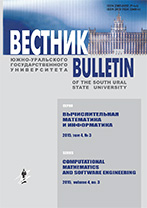|
Computational Mathematics
Parallel implementation of minimum spanning tree algorithm on CPU and GPU
A. S. Kolganovab
a Lomonosov Moscow State University (GSP-1, Leninskie Gory 1, Moscow, 119991 Russia)
b Keldysh Institute of Applied Mathematics (Miusskaya sq. 4, Moscow, 125047 Russia)
Abstract:
Solution of the finding a minimum spanning tree problem is common in various areas of research: recognition of different objects, computer vision, analysis and construction of networks (eg, telephone, electrical, computer, travel, etc.), chemistry and biology, and many others. Processing large graphs is a quite time-consuming task for the central processor (CPU), and in high demand at the present moment. The usage of Graphics processing units (GPUs) as a mean to solve general-purpose problems grows every day, because GPUs have more computing power than CPUs. This article describes the methods of compression and conversion of graphs in standard formats to increase the efficiency of their processing. The search algorithm of minimum spanning trees has been used for researching the proposed approaches. The possibility of a hybrid implementation of this algorithm has been investigated. The highest results were obtained on the large R-MAT and SSCA2 graphs.
Keywords:
MST, parallel graph processing, Boruvka algorithm, CUDA, large graphs.
Received: 06.05.2016
Citation:
A. S. Kolganov, “Parallel implementation of minimum spanning tree algorithm on CPU and GPU”, Vestn. YuUrGU. Ser. Vych. Matem. Inform., 5:3 (2016), 5–19
Linking options:
https://www.mathnet.ru/eng/vyurv141 https://www.mathnet.ru/eng/vyurv/v5/i3/p5
|

| Statistics & downloads: |
| Abstract page: | 477 | | Full-text PDF : | 437 | | References: | 45 |
|




 Contact us:
Contact us: Terms of Use
Terms of Use
 Registration to the website
Registration to the website Logotypes
Logotypes







 Citation in format
Citation in format 